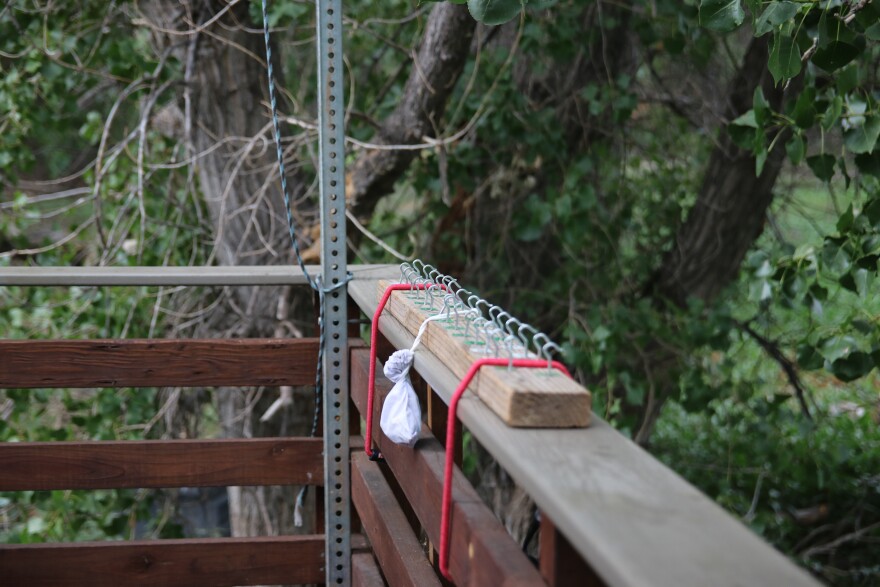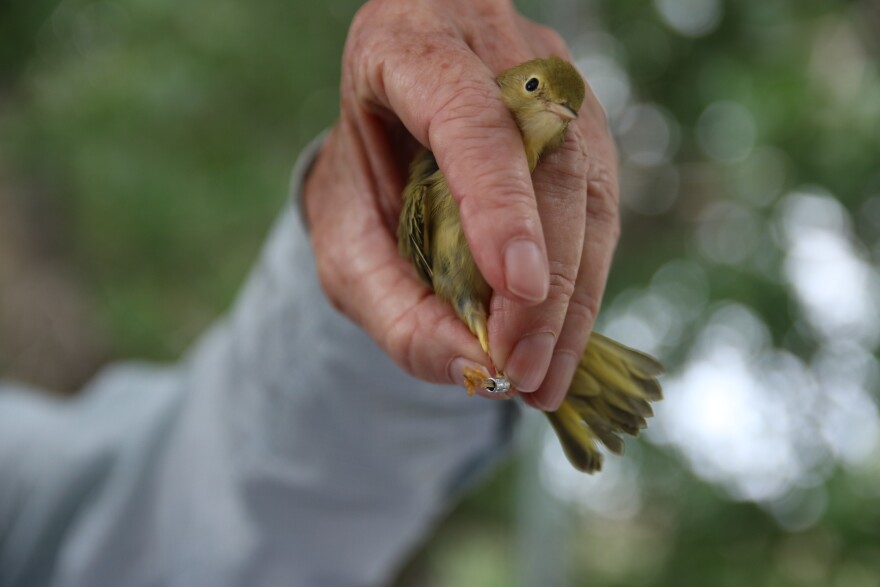The sun is just peeking over the horizon as Meredith McBurney walks up to a table with a cloth bag. She pulls out a tiny wiggling bird with bright, yellow feathers and red streaking on its breast.

“This is a yellow warbler,” she said. “It’s one of our most commonly caught species. Absolutely gorgeous birds.”
McBurney measures the length of the wing and tail feathers and determines if they have been replaced since birth. She blows gently on the bird to see if the bird has accumulated enough fat – a key indicator if the bird will do well with migration.
“That's what they use as their energy source. It's gasoline in your car,” she said. “If they don't have enough fat, they'll start to use their muscle, because they have to move, and compromise their health incredibly, and they probably won't survive.”
Then she places the bird in a PVC pipe and weighs it. The bird comes in at 11.3 grams – about the weight of two nickels. Then she puts it in her hand and releases it back into the wild.

McBurney caught this bird from light nets placed at the Bird Conservancy of the Rockies banding station at Barr Lake State Park. It’s a popular rest stop for birds on their journey down south. She’s tracked birds there since 1998.
“How can you not like this? Birds are so wonderful,” she said. “You have something that's so tiny and looks so fragile, but is really so tough and so strong. I never stop being amazed by what birds can do."

The work is done by volunteers, like Cynde Barnes. She brought her four-year-old granddaughter out to one of the bird banding stations and got hooked. She’s been helping out for 11 years.
“They brought in fresh worms and talked about birds eating the worms. I just thought that was the coolest thing,” she said. “It's really important work and being out here with people who really know what they're talking about, and just enjoying the birds, it's nice.”
McBurney’s goal is to understand the entire life cycle of migration better – from here, to Central and Southern America, and back. That migration cycle applies to 70% of all North American birds.

“Because they have two homes, we have to understand not only this home and keep this area good and healthy and full of insects for that bird, but also wherever it goes in between here and where it ends up in Mexico,” she said.
She’d usually band this yellow warbler, but the bird already has one from a few days ago. It’s hard to make any conclusions, but McBurney said she’s seeing fewer birds than past years. As she walked around the nets, all she was hearing was crickets.

“The yellow warbler, we've caught four, maybe five,” she said. “I mean, there are years where we catch 20 or 30 in the first few days…we've had one slow day, but never had four slow days in a row. This is unusual.”
She thinks it could be because the researchers had to move locations due to dam repairs at the park. Or it could be that the birds are staying longer in their breeding grounds since they came back late in the spring. McBurney doesn’t exactly know why yet.
These observations are in line with what many other ornithologists, or bird scientists, are seeing. The latest State of the Birds report shows around one-third of U.S. birds –229 species– are of high or moderate conservation concern. Grassland and aridland species have seen steep drops. And suitable habitat continues to be on the decline.

“By the time you recognize that something is going extinct, it's too late,” she said. “You got to get it somewhere in the process.”
McBurney believes that her work here is one way they can track and figure out an answer.
“We don't know what's happening with birds unless we study them at some level,” she said. “Being able to document both good years and bad years, years when some species are really prevalent, maybe others aren't, that’s what science is all about.”
Anyone can come observe and learn at the banding station at Barr Lake. There are a few morning sessions Tuesday through Sunday, through October 23rd. Tickets are $7 and can be found on the Bird Conservancy of the Rockies website.






